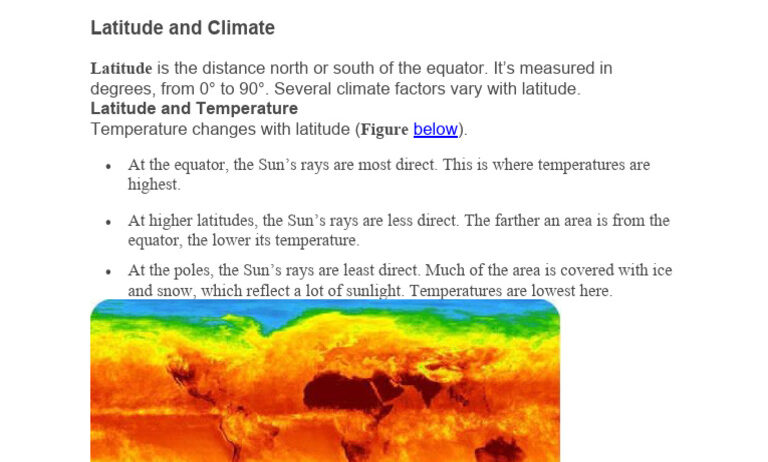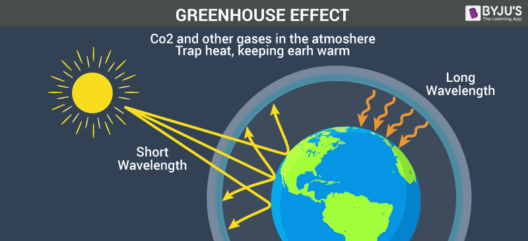The relationship between climate and latitude is a fundamental concept that influences ecological systems, weather patterns, and human activities around the globe. By exploring this connection, we uncover critical insights into environmental challenges and the unique adaptations of various biomes. Understanding how climate varies with latitude can provide clarity on issues such as agricultural productivity, biodiversity, and climate change. In this article, we will unravel the intricate interplay between latitude and climate, highlighting the implications for our planet’s future.
Understanding Latitude: The Coordinates of Climate
Latitude is defined as the angle, measured in degrees, that indicates how far north or south a location is from the equator. The equator, situated at 0° latitude, serves as a pivotal point, with the poles at 90° north and south. This positioning inherently affects solar radiation exposure, as the sun’s rays strike the Earth at varying angles depending on latitude. Consequently, regions closer to the equator enjoy a more consistent, warm climate, while those nearer the poles experience a drastic fluctuation between warm summers and frigid winters.
This variance in solar energy distribution not only shapes temperature ranges but also determines precipitation patterns and seasonal changes. Tropical regions, with their low-latitude proximity, are characterized by high humidity and abundant rainfall, fostering lush ecosystems. In contrast, northern and southern latitudes often exhibit drier conditions, leading to arid landscapes or tundra environments. The unique climatic niches created by latitude have direct implications for flora and fauna, which have evolved specific adaptations to thrive in their respective habitats.
The Influence of Latitude on Temperature Variation
One of the most salient effects of latitude is its impact on temperature. It is widely acknowledged that as one moves away from the equator towards the poles, there is a discernible drop in average temperature. This phenomenon can be attributed to the angle of sunlight incidence, which diminishes with increasing latitude. In lower latitudes, sunlight is concentrated over a smaller area, resulting in warmer temperatures, whereas higher latitudes experience a dispersal of solar energy, leading to cooler climates.
For instance, tropical regions typically maintain average temperatures above 20°C (68°F) throughout the year, supported by a consistent influx of solar radiation. This leads to conditions ripe for diverse ecosystems, including rainforests and savannas. As one travels to temperate and polar regions, average temperatures fluctuate significantly; the annual average temperature in these areas can be below 10°C (50°F), often perpetuating longer winters and shorter growing seasons.
The Role of Latitude in Precipitation Patterns
Latitude not only governs temperature but also plays a critical role in determining precipitation patterns across the globe. The Hadley Cell, a large-scale atmospheric circulation pattern, is a prime example of how latitude influences moisture distribution. As warm air rises near the equator, it cools and precipitates, creating wet tropical climates. Conversely, the descending air at around 30° latitude results in arid conditions, contributing to the formation of deserts such as the Sahara.
Mid-latitude regions often experience varying precipitation levels, influenced by seasonal changes and frontal systems. This gives rise to temperate climates with distinct wet and dry seasons. In stark contrast, polar latitudes contribute to colder, drier climates, where the limited moisture condenses into snow rather than rainfall. These climatic differences reveal the importance of latitude in agriculture, as crop yields tend to be higher in regions with adequate rainfall and favorable temperature profiles, underscoring the intricate connectivity between climate and human livelihood.
Adapting to Latitude-Driven Climate Changes
In the context of climate change, understanding how latitude affects climate is essential for developing adaptive strategies. As global temperatures rise, regions at different latitudes will be affected variably, requiring tailored approaches to mitigate adverse outcomes. For instance, tropical areas may face increasing incidences of severe weather events, such as hurricanes and flooding, while polar regions could encounter rapid ice melt and rising sea levels, resulting in habitat loss and climate refugees.
Moreover, agriculture will need to adapt to shifting climatic zones enforced by latitude-driven changes. Crop varieties that thrive in warmer climates may expand towards higher altitudes and latitudes, necessitating agricultural innovation and research aimed at ensuring food security. Urban planning must also consider these climatic variations, implementing sustainable practices that account for expected changes in weather patterns.
The Importance of Global Awareness
The intricate relationship between latitude and climate underscores the necessity for global awareness and cooperative efforts to address environmental challenges. As individuals, communities, and nations confront climate change, understanding the local and global implications of latitude-related climatic issues will empower informed decision-making. Environmental education plays a vital role in enlightening citizens about the effects of climate on latitude and the urgency of adopting sustainable practices across all sectors of society.
In conclusion, the interplay between latitude and climate shapes our planet in profound ways, affecting weather patterns, biodiversity, and human geography. As we navigate the complexities of climate change, recognizing this connection is critical to understanding our environmental reality. Through informed awareness and sustainable practices, we can work towards preserving the planet for future generations, adapting to the realities posed by our ever-changing environment.






